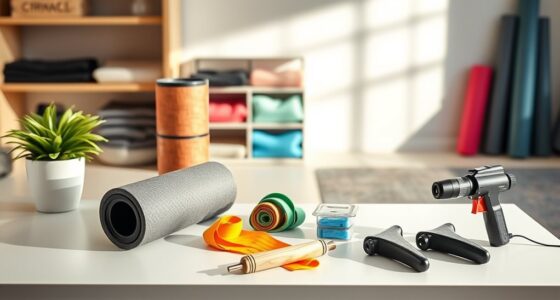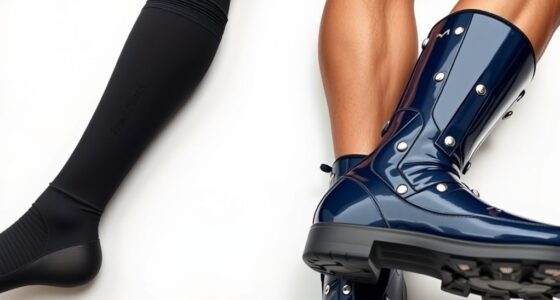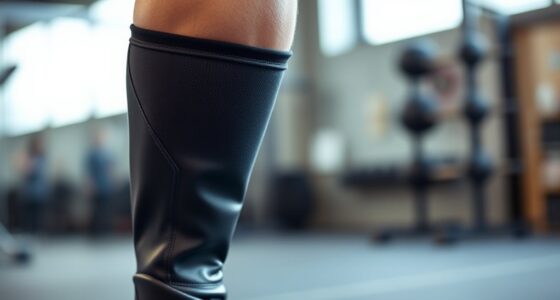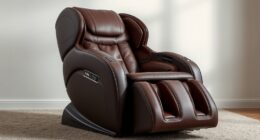Infrared therapy devices use deep-penetrating light to help speed up muscle recovery by reducing pain, inflammation, and promoting tissue healing. They’re safe, easy to use at home, and work without side effects. You can target specific sore areas or treat broader muscle groups, making recovery more convenient and cost-effective. If you want to discover how to maximize these benefits and choose the right device, keep exploring how this innovative light therapy can support your training.
Key Takeaways
- Infrared light penetrates deep tissues to reduce inflammation and promote cellular repair.
- It accelerates muscle recovery by increasing blood flow and oxygen delivery to affected areas.
- Regular use of infrared devices can minimize soreness and support faster healing after workouts.
- Infrared therapy is safe, non-invasive, and easy to use at home for targeted muscle relief.
- Customizable settings allow personalized treatment durations and intensities for optimal recovery.
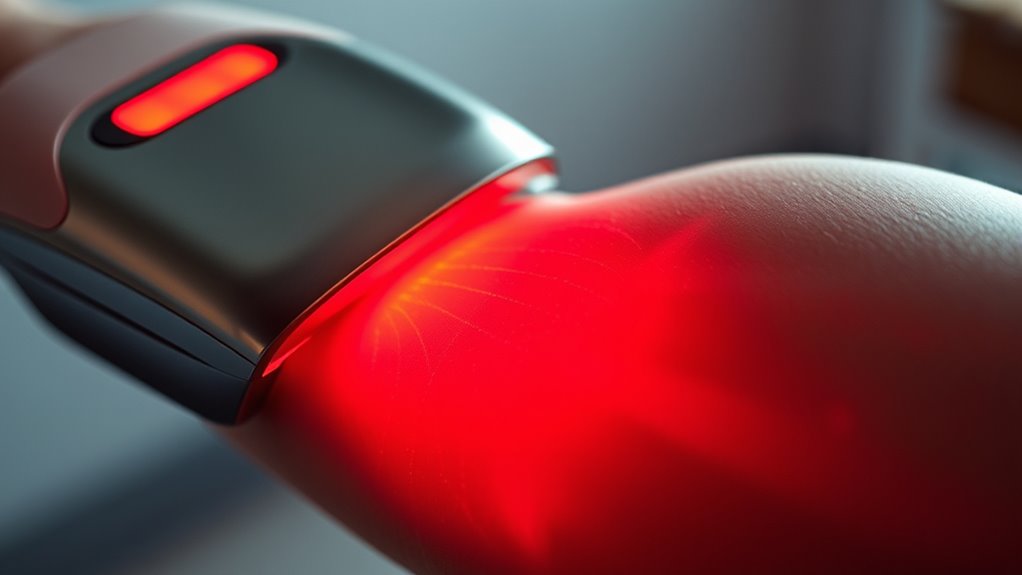
Infrared therapy devices have gained popularity as a non-invasive way to relieve pain, reduce inflammation, and promote healing. If you’re an athlete or someone who leads an active lifestyle, you’ll find these devices particularly beneficial. They can help speed up recovery after intense workouts, soothe sore muscles, and improve overall performance. The benefits for athletes are significant because infrared light penetrates deep into tissues, stimulating cellular repair and increasing blood flow. This process accelerates muscle recovery, minimizes downtime, and can even help prevent future injuries by keeping muscles healthy and flexible.
One of the biggest advantages of infrared therapy devices is their versatility for home use options. You no longer need to schedule appointments at clinics or spend money on frequent therapy sessions. Many devices are designed with user-friendly features, allowing you to enjoy professional-grade therapy right in your living room. Compact, portable models fit easily into your daily routine, making it simple to incorporate recovery sessions into your busy schedule. Whether you want to target specific areas like your back, shoulders, or legs, or prefer a broader treatment, there are devices suited for your needs.
Using infrared therapy at home is convenient and cost-effective. You can use these devices after workouts, during rest days, or whenever you feel muscle tightness or discomfort. The process is straightforward: position the device close to the target area, turn it on, and let the light do its work. Many models come with adjustable settings, so you can customize the intensity and duration based on your comfort and recovery goals. This ease of use makes regular therapy sessions accessible, helping you stay consistent without the hassle of visiting a professional.
Additionally, infrared therapy devices are generally safe when used correctly, making them a reliable addition to your recovery regimen. They’re non-invasive, painless, and free of side effects common with some medications or invasive procedures. For athletes, this means you can manage soreness and inflammation without disrupting your training schedule. Incorporating portable options into your routine can enhance flexibility and ease of use, especially when traveling or on the go.
Frequently Asked Questions
Are Infrared Therapy Devices Safe for All Skin Types?
Infrared therapy devices are generally safe for most skin types, but you should consider your skin sensitivity and device compatibility. If you have sensitive skin, start with shorter sessions and monitor how your skin reacts. Always check if the device is suitable for your skin type, and consult a healthcare professional if you have concerns. Following these precautions guarantees safe, effective use of infrared therapy for muscle recovery.
How Often Should I Use an Infrared Therapy Device?
For ideal sessions, you should typically use an infrared therapy device 3 to 5 times weekly. Consistency is key, so don’t overdo it—more isn’t necessarily better. Pay attention to your body’s responses, and if you notice discomfort or irritation, reduce usage. Follow the manufacturer’s guidelines and consult with a healthcare professional to tailor the usage frequency to your specific needs, ensuring safe and effective muscle recovery.
Can Infrared Therapy Replace Traditional Physical Therapy?
Infrared therapy can’t fully substitute traditional physical therapy, but it can be a helpful alternative treatment. While infrared light boosts circulation and reduces pain, therapy effectiveness varies based on your condition. You should use it alongside professional guidance rather than as a sole solution. Always consult your healthcare provider to ensure it’s appropriate for your specific needs and to determine if combining treatments offers the best recovery outcome.
Are There Any Long-Term Risks Associated With Infrared Light Exposure?
You might wonder if infrared light exposure has long-term risks. Generally, it’s safe when used properly, but there’s a chance of skin irritation if overexposed. Also, eye safety is important; direct or prolonged exposure could harm your eyes. To minimize risks, follow guidelines, avoid direct eye exposure, and limit session durations. If you have sensitive skin or eye conditions, consult a healthcare professional before use.
What Is the Expected Timeframe to See Muscle Recovery Results?
They say patience is a virtue, and with infrared therapy, you’ll start seeing visible improvements in your muscle recovery within 2 to 4 weeks. Your recovery timeline depends on factors like injury severity and consistency of use. Most users notice reduced soreness and improved mobility early on, but full results may take longer. Stay committed, and you’ll be amazed at how quickly your muscles bounce back.
Conclusion
Now that you know how infrared therapy devices can speed up your muscle recovery, aren’t you ready to experience the benefits firsthand? With their ability to penetrate deep into tissues and reduce inflammation, you might wonder why you didn’t try this innovative treatment sooner. Embrace the power of light to heal and restore your body naturally. Isn’t it time you took control of your recovery journey and felt your best again?



